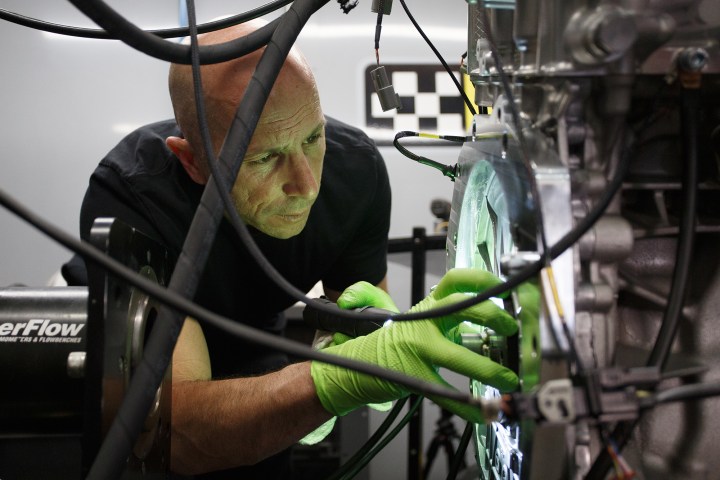
A couple months ago, award-winning engine builder Stephan Papadakis gave himself a challenge: to get 1,000 horsepower out of the new Toyota-BMW B58 engine found in the 2020 Toyota Supra. In the first episode of a four-part series, Papadakis showed us the initial engine removal and complete teardown. In the second episode he showed us the upgrades he was making to the engine’s internal parts. For the third episode, Papadakis revealed how he assembles a high performance racing engine, and the steps he took to get this engine ready for the dyno.
Now in the fourth and final episode, Papadakis takes us into the dyno room as he tunes the Supra’s B58 engine up to his target power output. Watch the final chapter below:
As we have with every step on this journey, Digital Trends met with Papadakis for an exclusive interview.
Your goal was 1,000 horsepower, what total did you end up getting?
Stephan Papadakis: On our third day on the dyno, after spending several days conservatively pushing to get past a 950 hp plateau, we got to 1,009 horsepower with our 2020 Toyota GR Supra engine. It has all been hypothetical to this point so we’re excited to have our proof of concept on the dyno. And it isn’t over yet: we think there’s a ton more potential in this engine.
Were there any unexpected developments as you went through the process?
Stephan Papadakis: I actually have limited experience on an engine dyno — really only a couple of days with our old NASCAR engine years ago — so this was a relatively new experience for us.
But even though I’ve mostly worked with a chassis dyno on our race cars, I definitely preferred running on an engine dyno for this initial phase. It’s a pure power readout direct from the engine to the measuring devices so it takes the vehicle’s drivetrain out of the equation and we’re not dealing with variables like tire slip on the rollers, or even cooling limitations. And the engine is a lot easier to work on in the stand versus bolted into the vehicle.
It isn’t that easy to find a place with a dyno capable of handling our horsepower. For most motorsports, the horsepower output is well under 1,000. Even some top-level NASCAR teams don’t have an engine dyno that goes over 1,000. We’re lucky to have Mountune so close: they have a 1,500 horsepower capable dyno, and it’s five minutes from our shop. People who have been following this build will recognize that is a theme for us: it’s an enormous benefit that we’ve got such a supportive group of people here in the Southern California aftermarket industry who can make a project like this possible.

Initially, we had to do some fabrication work just to get the engine running at Mountune. The dyno is built for traditional racing engines and because this 2020 Toyota GR Supra engine is so new, we needed to design and manufacture some components to adapt our engine to the engine dyno. The bell housing that fastens the engine to the power absorption unit and we had to make an adapter so that we can transmit the power from the crankshaft to the input shaft of the dyno.
After that, the installation of the engine onto the dyno actually went pretty smoothly. The thing about testing is that you work to the limit, break something, fix it, and then find the new limit. So, it wasn’t really unexpected when a few things went sideways during the dyno test. We work through it all in the video, but we melted some things and shot sparks all over the place, which was pretty interesting to see.
Where did you find the biggest gains?
Stephan Papadakis: Our biggest gains came from increasing the turbo boost level. We’re running a much larger turbocharger than factory and much higher boost levels than factory — over 40 pounds per square inch. What gives us the ability to do that is all the modifications we’ve done to the block like the forged rods and pistons, and the standalone engine management system.
Development doesn’t end at this stage. Now that we have confidence in the platform and our direction, we’ll continue to evolve. A great performing engine isn’t just one that makes good power. It also needs to be something that drives well and is reliable. So once we get the engine into a car, the development will continue.
How did the live build go at SEMA? Any surprises?
Stephan Papadakis: The live build at SEMA was really fun. It was something new to be out there on the show floor building an engine in front of friends and fans, both live and on the stream. I’ve never done anything like that before and it brought me back to my old tuner shop days when we’d have friends come around after hours and we’d all work on cars together. Those were some of the most enjoyable times I’ve had with cars and it was great to re-live that a little bit at SEMA this year.
What’s next, both for the Supra and your next project?
Stephan Papadakis: We didn’t make the 1,000 just for YouTube. We have more plans for this engine but we’re not ready to talk about them just yet. If you want to see more, be sure to subscribe to the PapadakisRacing YouTube channel and keep watching!


